WARFARE
IN THE
AGE
OF REASON

The rules, designed primarily
for mid century conflict are eminently suitable, as is, for early century
warfare. However, there were a few nuances of early century combat that
led to important developments later in the century that are not fully reflected
in the rules. |
Here then, is our unofficial
modifications for the Era of Marlborough.
These minor changes are meant
as a guide for those who would like to game this period's flavor, but with
the full character of the rules system of Age of Reason. |
GAME
SCALES &
BASING
Nominal scales are interpreted
as thus:
-
1” = 20 - 25 yards/meters
-
1 figure represents 40 – 60
men or horses
-
1 turn represent a slot of time
from 5 minutes to 1/2 hour.
(This could represent
5 minutes of action and 25 minutes of inactivity)
There were two very different
firing systems in use in the first part of the century. Those nations adopting
a "platoon Firing" system, and those adopting the "Volley Fire" system.
These two systems produce very different frontages of units.
Volley fire platoons use
a deeper, narrower formation. This is reflected in the basing diagram.
Horses are mounted on a narrower
frontage. Look at this contemporary engraving of the storming of the Schellenberg
to get a better idea of the very narrow “cheek-to-cheek” formation of the
horse. The narrower frontage we employ not only reproduces this look and
feel, but also allows one to field squadrons at a realistic frontage.
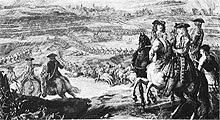
Schellenberg
(select
image to enlarge)
Under nominal circumstances,
the units are represented as shown on the right, However, in certain circumstances,
battalions were very under strength, For example, at the Battle of Blenheim,
the French battalions were very under strength, having an average strength
of some 300 - 350 men per battalion. In these circumstances, the battalion
sizes given on the examples on the right, may simply represent a regiment
of two smaller battalions or 1 larger one. The nominal strength of an Austrian
regiment, to cite another example, was 2,200 men typically organized into
three battalions. However, when the regiment was under strength, rather
than three smaller battalions, they would be re grouped into 2 battalions.
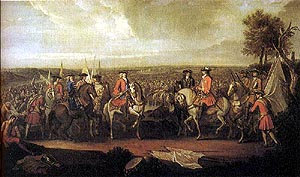
Blenheim
(select
image to enlarge)
Dismounted dragoons are also
represented. We assume dragoons operating as infantry were not as
well rehearsed in fire drill as their nations' infantry so only allow them
the performance of volley fire. They are all based as per their nations'
infantry, but even if based as platoon infantry, they do not get their
fire modifiers. (see new modifiers below)
Grenadiers
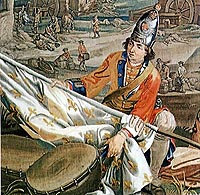
Grenadier
(select
image to enlarge)
Most battalions had one or
two grenadier companies deployed on the flanks of the battalion, which
we model for aesthetic value. They add no special factors to the unit but
provide some variety. Under some circumstance outlined later, these Grenadiers
may have been banded together to form all Grenadier formations. These were
ad-hoc formations usually done to support siege actions or other specialized
situations.
|

|
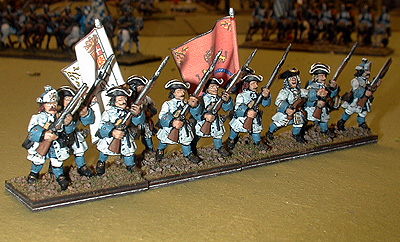 |
|
Dutch Battalion Waes.
Foundry Figures
|
Platoon Fire Battalion Basing.
This represents the Battalions
of those nations adopting firing by platoons. It is the basing as is given
in The Rules. It represents 480 -720 men in three ranks occupying a frontage
of some 819 ft.
It is the typical formation
of Holland, Prussia, England (Scottish and Irish regulars in the English
Army - British Army (from 1707) and possibly Denmark in English or Dutch
pay.
The basing is 1½"
frontage by 1" depth. Typically 12 figures. |
|

|
5 Rank Volley Fire Battalion Basing
from 1700
This represents those battalions
using the volley fire system, in its earlier form. This represents 480
-720 men in 5 ranks occupying a frontage of 390 ft. This was the official
formation of France, Spain and used also by Portugal and some German States.
It was not formally changed to the wider volley fire width (below) by France
until 1707, however, many battalion commanders ignored the 5 rank formation
and adopted the more useful 4 rank formation (below).
The basing is 1½"
frontage by 1¼" depth. Typically 12 figures. |
|

|
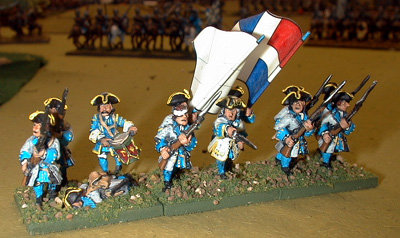 |
|
French Battalion
Poitou. Old Glory Figures
|
4 Rank Volley Fire Battalion Basing
This represents those battalions
using the volley fire system, in its later form. This represents 480 -720
men in 4 ranks occupying a frontage of 486 ft. This formation was in use
by Austrian and many of the German states from early in the war, but was
not officially adopted by France until 1707. However, many battalion commanders
ignored the official 5 rank system and adopted this more useful 4 ranks
system.
The basing is 1½"
frontage by 1¼" depth. Typically 12 figures. |
|
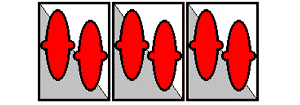
|
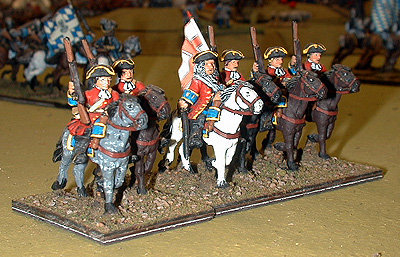 |
|
3 Squadron English
Dragoon Regiment. Foundry Figures
|
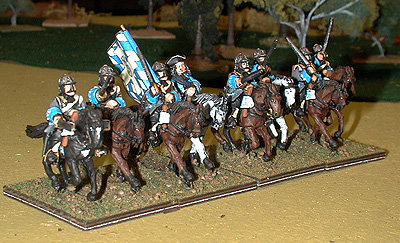 |
|
4 Squadron Bavarian
Cuirassiers Regiment. Foundry Figures
This represents horses on a
narrower base than provided by the rules (1½" frontage by 2" depth).
This basing requires a slight staggering of the figures with some manufacturers,
to make them fit. It does however provide for a more realistic frontage
and appearance (see engraving). Typical squadron strength was 120 men,
which fits withy our figure scale. |
|
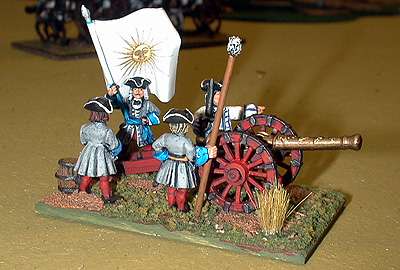
|
|
French Company of
4 Medium Guns. Old Glory Gun, Artllerists from BloodAxe and Foundry.
This represents a battery of
4 guns. It is based on a 2" frontage with a 3" depth. The gun is not affixed,
so can be replaced with varying sizes of gun. The gunners can also move
away, leaving the gun on the field. Limbers in this period were usually
contacted civilians who were not likely to stay on the field after the
guns were deployed. |
|
|
| ARTILLERY
Battalion Guns.
It appears that artillery
pieces listed in contemporary orders of battle also include the "light
battalion guns" that were often operated by individual infantry battalions.
Therefore, when using the army listrs from WAOR, the listings for artillery
pieces (light guns) include battalion guns. For those units that fielded
battalion guns (as designated by the lists) the light guns must be distributed
among them.
Light guns, fielded from
the army lists include battalion guns of 4lb and less where required.
Medium guns are those of
greater than 4 LB up to 6 LB in projectile weight.
Heavy guns are those of 8lb
– 12lb and occasionally 16lb or 18lb of perhaps lesser quality.
Siege guns are those of nominally
24lb or greater, and mortars.
NEW
ARTILLERY MOVEMENT RATES AND RANGES
BOLD represents a
change from the rules.
Italics represents
an addition to the rules.
Light field pieces can
be prolonged 4” per turn, allowing them to keep up with slow moving
infantry. This reflects their use as battalion guns where appropriate
Medium field pieces may
be prolonged 2 “ per turn.
Heavy field pieces may
be prolonged 1” per turn.
Medium, and Heavy guns
all have a long range out to 30”. These rate guns could all fire out
to 1200 meters with fairly equitable accuracy. This range change is to
compensate for the lack of limbers, which leave before the start of the
battle.
Howitzers are medium guns
that can be moved as light field pieces. They have no “partridge shot”
range (referred to as “canister shot” in the rules).
All artillery may be deployed
18” in from edge of board (on a 5 feet wide table) for an attacking army,
or 24” from the edge for defending army.
Siege Artillery may not be
moved after deployment. It may only pivot on a turn in which it may not
fire.
Light breach loading guns
from the army lists of Savoy, Austria and Hungary add +1 die for their
faster rate of fire. |
HORSE
BOLD represents a
change from the rules.
Italics represents
an addition to the rules.
Those horse as designated
as “Charging at Trot” by the army lists, subtract 4” from their charge
move.
Cavalry charging at the
trot get a +1 on the melee chart. (instead of +2)
(We
originally had a more complex method of resolving charging pistol firing.
The following is an elegantly simple test from Charles Sharp.)
Those horse designated
as “Pistol Firers while Charging” test to fire pistols on entering melee.
The following results result
in their opponents being successfully disordered by pistol fire at contact
with the resulting negative melee modifier.
|
Charger Rolls 1d6 rolling
below results in successful Pistol Fire
|
|
MG 1
|
1-2
|
|
MG 2
|
1-3
|
|
MG 3
|
1-4
|
|
MG 4
|
Automatic
|
Horse with carbines, may
stand and receive charges from other horse at the halt and issue carbine
fire.
Dragoons may not dismount
during game – but may, at Generals (or scenarios) wish, start the game
dismounted. One Dismounted Dragoon unit per side may at start of the game
attempt to take a forward terrain position (no closer than 24” from enemy
board edge). Side declares unit and terrain feature. If both sides choose
the same feature, both dragoon units start 3” back from feature (and must
fight over it). Any dragoon unit that elects this option must take an immediate
morale check at start of game from the position of the terrain feature
- and follow the results. |
FOOT
BOLD represents a
change from the rules.
Italics represents
an addition to the rules.
Foot may wheel, only at half
speed. This was a difficult procedure before the reintroduction of the
cadenced step.
Foot may not incline (same
reason).
Foot may only about face,
or wheel, it may not turn to flank.
Battalion Squares may
not move.
SMALL
ARMS TABLE MODIFIERS
BOLD represents a
change from the rules.
Italics represents
an addition to the rules.
Weapon Ranges
Musket Close 0-2”
Normal 5”
Carbine Close 0-2”
Normal 3”
Volley fire units’ initial
fire, was by all accounts quite formidable, but fire control was quickly
lost. Platoon fire tactics provided a steady stream of accurate fire. Therefore
the following factors replace first fire factors from list.
Volley fire (first fire)
+2
Platoon Fire (each turn)
+1
Volley fire battalions,
may not fire while advancing. (Platoon fire units may fire if moved
less than half – as per rules)
All nations' foot units
may fire to their rear at -3 (as per square side) to reflect firing
while retiring. They may do this even at a full move (cumulative with moving
modifiers) and if in either column or line.
Voluntary Break.
Units may voluntary break
and move at rout speed to a designated terrain feature (distance from all
known enemy must be increased, and distance to base edge must be decreased).
Upon reaching the terrain feature, the unit gets a “one time” rally attempt
in the rally phase with a –1 to the roll AND a -? For an accompanying Leader.
If it fails, it stays routed,
There are no other modifiers. |
MELEE
CHANGES
BOLD represents a
change from the rules.
Italics represents
an addition to the rules.
Under Melee table – delete
this line
-1 vs. armored cavalry
In its place add this
line
-1 vs. armored cavalry
OR dragoons Vs other
This is to reflect that dragoons
Vs any non dragoons on horse should be inferior due to poorer quality horses,
or if on foot, due to lack of bayonets.
All dismounted Dragoons
use volley fire.
Additional Small Arms
factors for Horse.
Mounted Carbines Stationary
–1
Mounted Carbines Moving
–2
(May move full and fire
except when charging to contact – then may only
pistol fire as above)
Mounted units designated
as armed with carbines may "caracole". This allows them to fire all ranks
of a column or two squadron wide line, to reflect that the front units
peel off after firing to allow the following ranks to fire. |
| Notes
of Flank/Rear Support and Frontage.
For flank support,
a friendly unit must have some part of a flank base edge (or friendly contolled
terrain) within 3" of the testers' flank base edge.
For rear support,
the supporting unit must be directly behind the testers rear and close
enough that the supporter can reach the tester with charge movement (without
wheeling). The supporter must be parallel to and facing in the same direction
of the tester.
Frontage.
Hits on a unit represent
the gradual degradation of a units ability to stay for the battle due to
gradually worsening resolve to stay and fight. They do not
represent dead on the battlefield.
A unit that has taken 75%
"loss", should be interpreted as a unit that has taken 75% of the degradation
necessary to force a compulsory rout form the table. Of course, it may
fail a morale result long before this.
When calculating frontage
(as a melle factor), a unit that has 75% "loss" has not lost 75% of it
men - it may have only lost 25 soldiers, but it has taken a 75% reduction
in the resolve necessary to stay and fight. Frontage in melee is therefore
the frontage in unit width (in inches), not in number of figures. Any variation
in the size of units due to casualties is represented in the "pip dice"
roll. |
GAMES
The Storming
of the Schellenberg
Army
Lists for The Grand Alliance
Army
Lists for Louis XIV
Return
to home page |













